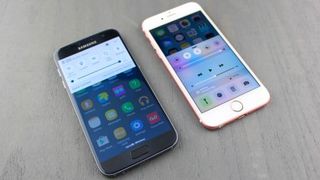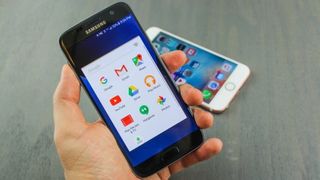Samsung Galaxy S7 vs iPhone 6S
Your Samsung vs Apple phone comparison for 2016
Interface and apps
This is where the Galaxy S7 and iPhone 6S contrast the most and why people usually stick with one phone over the other. Yes, they have many of the same apps, but the look and feel of each operating system is completely different.

Samsung runs Android Marshmallow skinned with its own TouchWiz interface, and it's no longer as unnecessarily complex as it has been in the past. Don't be afraid if the Galaxy S5 or Galaxy S4 scared you away.
What's here now is straightforward-looking software that has more customization than you'll find on an iPhone, and widgets are a big part of that. Having the weather, my to do list, my calendar and the Google search bar right on the home screens is better than staring at nothing but a grid of square icons.
Samsung does pre-load its phones with useless repeats apps, though. S Voice needs to not exist anymore in a world where Google Now fetches me what I want and does it successfully the first time. Google has it beat and Samsung knows it; S Voice has been shoved in a folder inside the app drawer. But like many pre-loaded apps, it can't be uninstalled, only "turned off." Worse, I don't need the generic email app when Gmail is here and now supports POP3. Yet it can't be deleted or turned off. It will always exist. I will always have two email apps on my phone.
The same goes for the dozen of carrier-imposed and Amazon-sponsored apps that came with my Galaxy S7 review unit in the US. You won't find such junk on any Apple phone.

iPhone 6S runs iOS 9.2.1, with iOS 9.3 on the brink, and its more streamlined and easier to use than any other operating system out there. It's the software that makes Apple's phones so appealing.
It's the idea of convergence that makes the default apps echo the Steve Jobs line "It just works." I can easily switch between a call, message and FaceTime video with ease, and iMessages is by far my favorite app to chat in. It sends all calls and messages - SMS included - to my phone, iPad and Mac, whether or not my phone are within Wi-Fi range.
Get daily insight, inspiration and deals in your inbox
Get the hottest deals available in your inbox plus news, reviews, opinion, analysis and more from the TechRadar team.
The iPhone 6S has a slick layout that's only going to get better with iOS 10 beta this summer, and its pressure-sensitive 3D Touch shortcuts make navigating the phone a tiny bit quicker. Just don't expect widgets in any forthcoming update. I've given up hope for those.
Specs and performance
The best part of upgrading your phone is that you're greeted with fresh specs that are faster and more powerful than your old phone, and the iPhone 6S and Galaxy fulfill that promise.

Samsung's phone is technically the fastest on the planet, with either a Qualcomm Snapdragon 820 processor in the US or a Samsung Exynos 8890 chip in the UK and everywhere else.
I didn't experience slowdown when using the "slower" US variant of the S7, and I really don't expect to, thanks to the 4GB of RAM. It keeps everything snappy.
I may run out of internal storage space eventually, as Samsung only included one option: 32GB. But that's where the returning microSD card slot becomes an essential feature.
The iPhone 6S takes advantage of the Apple-designed A9 processor, and while the phone only has 2GB of RAM, it feels just as fast.

That's because it runs a different operating system, one that Apple developed hand-in-hand with the hardware. Even with slower benchmarking scores, the 6S exhibits no noticeable slowdown.
With 16GB, 64GB and 128GB choices, there are three times as many internal storage options compared to what Samsung gives you. Just don't look for a microSD card slot. It's not the Apple way.
You're not going to be disappointed with either phone when it comes to specs and performance, unless you go with the paltry 16GB iPhone that suckers you into iCloud in a hot minute.
Current page: Interface, specs and performance
Prev Page Introduction, design and display Next Page Battery and cameraMost Popular


